Pre-existing health conditions and the risk of Covid-19
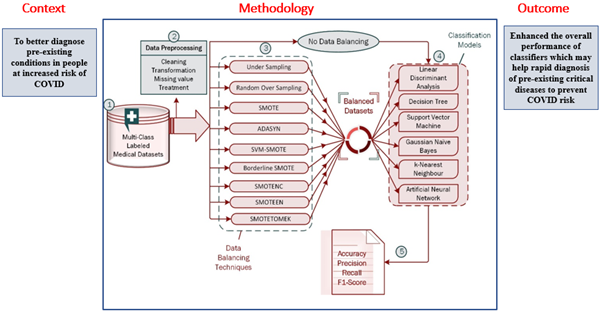 Individuals with pre-existing medical conditions are more vulnerable to Covid-19 and its variants. Patients in countries like India require early testing to diagnose crucial disorders to reduce the risk. Research at the Department of Computer Science and Engineering has come up with a system that automatically identifies and categorises diseases based on the patient’s medical test results. Assistant Professor Dr Ravi Kant Kumar published a paper Improving Performance of Classifiers for Diagnosis of Critical Diseases to Prevent COVID Risk as a co-author in the Q1 journal Computers and Electrical Engineering and has an impact factor of 4.152. With an accurate diagnosis, the required actions can be planned and executed to stop the patients from serious health issues as well as covid risk.
Individuals with pre-existing medical conditions are more vulnerable to Covid-19 and its variants. Patients in countries like India require early testing to diagnose crucial disorders to reduce the risk. Research at the Department of Computer Science and Engineering has come up with a system that automatically identifies and categorises diseases based on the patient’s medical test results. Assistant Professor Dr Ravi Kant Kumar published a paper Improving Performance of Classifiers for Diagnosis of Critical Diseases to Prevent COVID Risk as a co-author in the Q1 journal Computers and Electrical Engineering and has an impact factor of 4.152. With an accurate diagnosis, the required actions can be planned and executed to stop the patients from serious health issues as well as covid risk.
Abstract
The risk of developing COVID-19 and its variants may be higher in those with pre-existing health conditions such as thyroid disease, hepatitis C virus (HCV), breast tissue disease, chronic dermatitis, and other severe infections. As a result, early and precise identification of these disorders is critical. A huge number of patients in nations like India require early and rapid testing as a preventative measure. Machine learning methods for automatically identifying and classifying diseases have been created, and they function effectively when the dataset is well specified and balanced at every class level, including “no disease”. The problem of imbalance arises from the skewed nature of data, in which a large number of cases belonging to one class (known as the majority class) are classified correct, while the other class (known as the minority class) has lesser instances; is unfortunately misclassified by many classifiers. When it comes to human life, this kind of misclassification is unacceptable. To solve the misclassification issue and improve accuracy in such datasets, we applied a variety of data balancing techniques to several machine learning algorithms. The outcomes are encouraging, with a considerable increase in accuracy. As an outcome of these proper diagnoses, we can make plans and take the required actions to stop patients from acquiring serious health issues or viral infections.
Explanation of the research
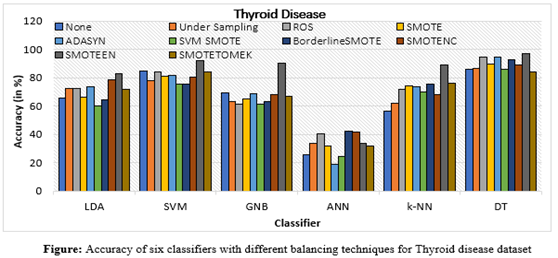 Lethal COVID-19 and its mutant forms may be more likely to arise in patients with pre-existing medical conditions such as thyroid illness, hepatitis C virus (HCV), breast tissue disease, chronic dermatitis, compromised immune systems, obesity, diabetes, heart disease, cancer, etc. For patients, an early and accurate diagnosis of these illnesses is crucial. Based on patient data, machine learning algorithms can assist in the early and quick detection of numerous diseases in a huge population like India. On the other side, machine learning algorithms perform poorly when a dataset has a class unbalanced problem. As a result, we used a variety of smote and its variants in this study to address the problems about the imbalanced class size. The experimental work showed that all six classifiers (DT, SVM, LDA, k-NN, GNB, and ANN) performed better overall on clinical datasets when class balancing strategies and classification techniques were combined. It recommends the use of the recommended classifications and class balancing technique with regard to specific data to identify the disease accurately and automatically
Lethal COVID-19 and its mutant forms may be more likely to arise in patients with pre-existing medical conditions such as thyroid illness, hepatitis C virus (HCV), breast tissue disease, chronic dermatitis, compromised immune systems, obesity, diabetes, heart disease, cancer, etc. For patients, an early and accurate diagnosis of these illnesses is crucial. Based on patient data, machine learning algorithms can assist in the early and quick detection of numerous diseases in a huge population like India. On the other side, machine learning algorithms perform poorly when a dataset has a class unbalanced problem. As a result, we used a variety of smote and its variants in this study to address the problems about the imbalanced class size. The experimental work showed that all six classifiers (DT, SVM, LDA, k-NN, GNB, and ANN) performed better overall on clinical datasets when class balancing strategies and classification techniques were combined. It recommends the use of the recommended classifications and class balancing technique with regard to specific data to identify the disease accurately and automatically
For this work, Dr Ravi Kant Kumar has collaborated with Mr Vinod Kumar, Koneru Lakshmaiah Education Foundation, Vaddeswaram,India, and Mr Gotam Singh Lalotra, University of Jammu, India. Their future research will investigate and design the most effective multi-class balancing method to address the multi-class imbalance problem in medical data.
- Published in CSE NEWS, Departmental News, News, Research News
Sustainable IoT system for freshwater pearl farming
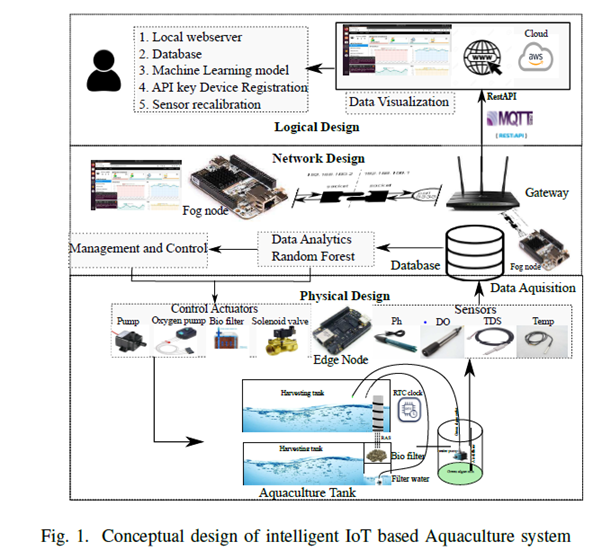
The Department of Computer Science Engineering is glad to announce that Dr Kshira Sagar Sahoo, Assistant Professor, has published an article titled ‘Sustainable IoT Solution for Freshwater Aquaculture Management’ in the Q1 journal, IEEE Sensors, having an Impact Factor of 4.325. The research was published in collaboration with Munesh Singh, from the Department of Computer Science and Engineering, PDPM IIITDM Jabalpur Campus, Madhya Pradesh, and Anand Nayyar, Graduate School, Faculty of Information Technology, Duy Tan University, Vietnam.
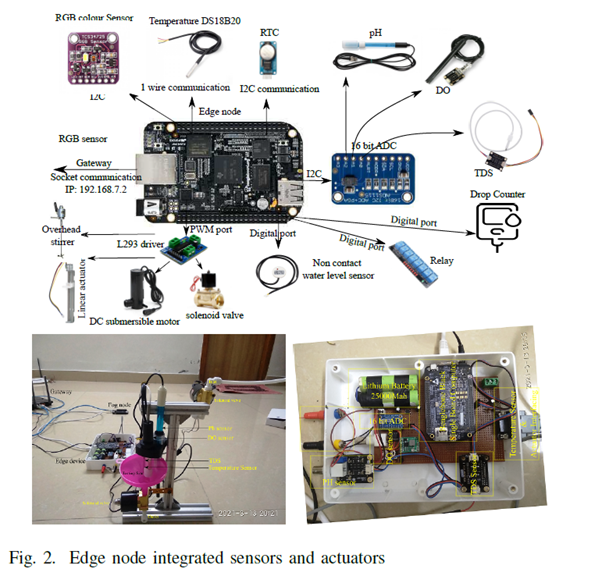 Freshwater pearl farming has the potential to generate an alternative source of income for small farmers. Indian freshwater river bodies have 51 types of species that can produce pearls. Still, India imports 2.4 billion dollars’ worth of pearls from China and Japan. To reduce the import burden on the Indian economy, the government encouraged the farmers to do integrated freshwater pearl farming. Aquaculture-based farming needs a small investment for the initial setup. Although the Indian government promotes aquaculture-based farming through subsidies and free training programs, farmers find it difficult to get success in aquaculture-based farming.
Freshwater pearl farming has the potential to generate an alternative source of income for small farmers. Indian freshwater river bodies have 51 types of species that can produce pearls. Still, India imports 2.4 billion dollars’ worth of pearls from China and Japan. To reduce the import burden on the Indian economy, the government encouraged the farmers to do integrated freshwater pearl farming. Aquaculture-based farming needs a small investment for the initial setup. Although the Indian government promotes aquaculture-based farming through subsidies and free training programs, farmers find it difficult to get success in aquaculture-based farming.
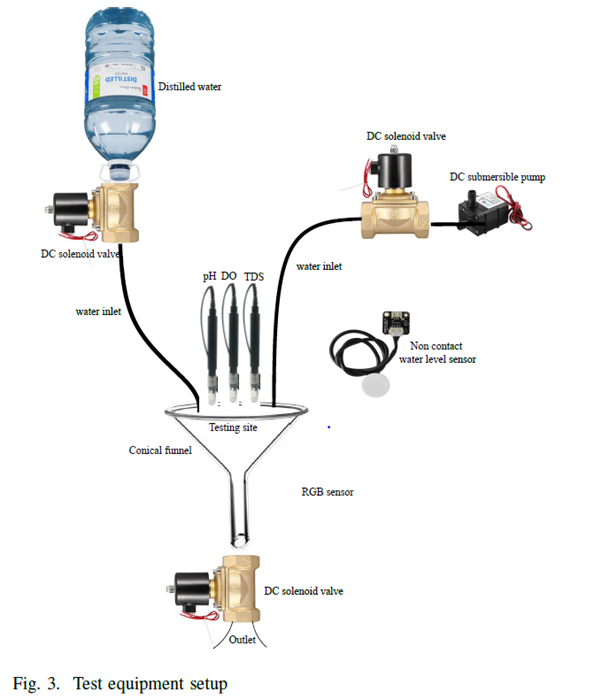 The paper proposes a comprehensive IoT system for freshwater pearl farming which has an intelligent control system for maintaining the aquaculture environment. The proposed system monitors and supports the habitable underwater environments for aquaculture. To train the farmers and educate them in pearl farming business is a time taking and skill-oriented job. The comprehensive IoT system will encourage farmers for freshwater pearl farming and proper utilisation of the government subsidy granted for aqua farming. In future, the researchers will consider more relative water parameters for robust forecast and analyse the best model for predictive analysis.
The paper proposes a comprehensive IoT system for freshwater pearl farming which has an intelligent control system for maintaining the aquaculture environment. The proposed system monitors and supports the habitable underwater environments for aquaculture. To train the farmers and educate them in pearl farming business is a time taking and skill-oriented job. The comprehensive IoT system will encourage farmers for freshwater pearl farming and proper utilisation of the government subsidy granted for aqua farming. In future, the researchers will consider more relative water parameters for robust forecast and analyse the best model for predictive analysis.
Abstract of the Research
In recent years, we have seen the impact of global warming on changing weather patterns. The changing weather patterns have shown a significant effect on the annual rainfall. Due to the lack of annual rainfall, developing countries like India have seen a substantial loss in annual crop production. Indian economy largely depends on agro products. To compensate for the economic loss, the Indian government encouraged the farmers to do integrated aquaculture-based farming. Despite government subsidies and training programs, most farmers find it difficult to succeed in aquaculture-based farming. Aquaculture farming needs skills to maintain and monitor underwater environments. The lack of skills for monitoring and maintenance makes the aquaculture business more difficult for farmers. To simplify the pearl farming aquaculture, we have proposed an Internet of Things (IoT)-based intelligent monitoring and maintenance system. The proposed system monitors the water quality and maintains an adequate underwater environment for better production. To maintain an aquaculture environment, we have forecasted the change in water parameters using an ensemble learning method based on random forests (RF). The performance of the RF model was compared with the linear regression (LR), support vector regression (SVR), and gradient boosting machine (GBM). The obtained results show that the RF model outperformed the forecast of the DO with 1.428 mean absolute error (MAE) and pH with 0.141 MAE.
- Published in CSE NEWS, Departmental News, News, Research News
Item feature refinement for improved content-based recommendation
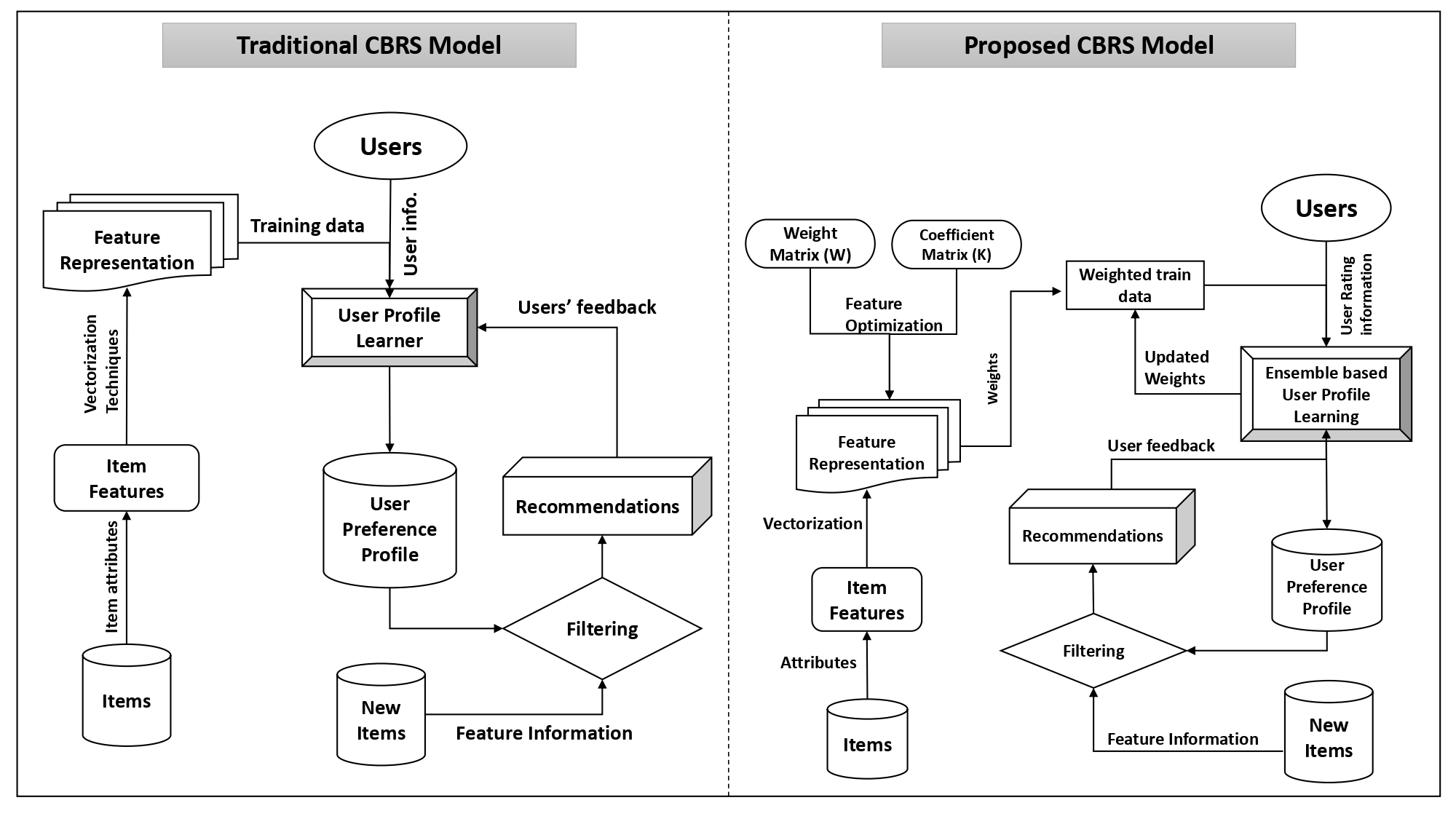
The Department of Computer Science and Engineering is delighted to announce that Dr Abinash Pujahari, Assistant Professor, has published his research article “Item Feature Refinement using Matrix Factorization and Boosted Learning based User Profile Generation for Content-Based Recommender Systems” in the journal Expert Systems with Applications having an Impact Factor of 8.665. The research was done in collaboration with Dr Dilip Singh Sisodia, Assistant Professor, National Institute of Technology Raipur.
This research focuses on improving the quality of information available about the features of various items so that it can be used for content-based recommendations. Content-based recommender systems are used in many e-commerce platforms (e.g., NetFlix, Amazon Prime, etc.). Here, the item (i.e., movies, TV shows) feature information is compared with the users’ past behaviour to recommend similar things. This research enables such systems to study the feature information for more accurate recommendations.
Most of the items’ feature information is sparse, redundant, and inconsistent. Matrix Factorization is used to avoid such inconsistencies. Further, iterative learning of user profiles is used using boosted learning approach for model building. The proposed research is compared with state-of-the-art related works using benchmark datasets and can be implemented in most e-commerce platforms and online streaming service providers. Dr Pujahari looks forwards to employing the same in group recommender systems where individuals have their preferences, in his future research endeavours.
- Published in CSE NEWS, Departmental News, News, Research News
Watermarking medical images for their secure transmission

The Department of Computer Science and Engineering is proud to announce that Dr Priyanka, Assistant Professor, and her research Scholar, Ms Kilari Jyothsna Devi have published their patent (application no: 202241033779 A), “A System and a Method for Watermarking Medical Images for the Secure Transmission of Images”. The patent was published on June 17, 2022, by the Indian Patent Office.
In the present technology, medical images and patient information are widely transmitted through a public transmission channel in e-healthcare applications. While sharing medical images or electronic patient records (EPR) through a public network, they can get tampered with or manipulated, leading to wrong diagnosis by the medical consultants. Similarly, one can easily claim false ownership of the medical images. This makes the confidentiality of the patient record at low cost a major concern.
The proposed novel MIW scheme ensures most of the watermarking characteristics such as high imperceptibility, robustness, security with low computational cost, temper detection and recovery in medical image transmission in real-time healthcare applications. In the future, they intend to design digital image watermarking schemes for the secure transmission of images over blockchain and cloud-based applications.
- Published in CSE NEWS, Departmental News, News, Research News
Two paper presentations at international research conferences
Presenting papers at international research conferences helps hone the research questions. Students from the Department of Computer Science and Engineering have attended two international research conferences and presented their papers drafted under the supervision of Assistant Professor V M Manikandan.
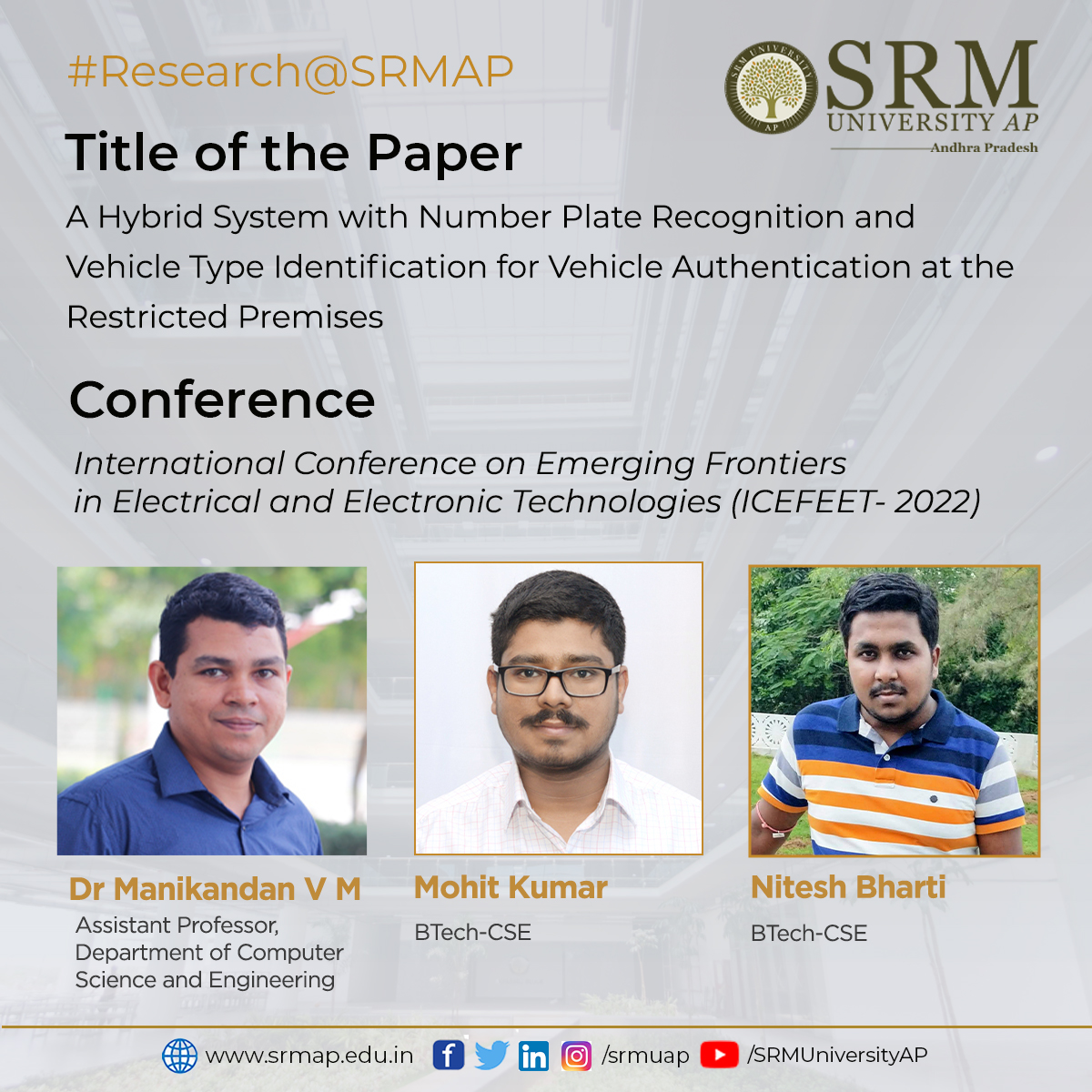 The International Conference on Emerging Frontiers in Electrical and Electronic Technologies (ICEFEET- 2022), organised by NIT Patna, India, was held from June 24 to 25. At the conference, BTech students Nitesh Bharti and Mohit Kumar presented the paper A Hybrid System with Number Plate Recognition and Vehicle Type Identification for Vehicle Authentication at the Restricted Premises. The work was composed under the guidance of Assistant Professor Dr V M Manikandan. The paper will soon be published in IEEE Xplore Digital Library (Scopus indexed). In the future, they plan to integrate the proposed algorithms with proper hardware units to completely automate the authentication of vehicles in restricted areas. The proposed computer vision-based systems can be used in restricted areas to ensure the entry of authenticated vehicles.
The International Conference on Emerging Frontiers in Electrical and Electronic Technologies (ICEFEET- 2022), organised by NIT Patna, India, was held from June 24 to 25. At the conference, BTech students Nitesh Bharti and Mohit Kumar presented the paper A Hybrid System with Number Plate Recognition and Vehicle Type Identification for Vehicle Authentication at the Restricted Premises. The work was composed under the guidance of Assistant Professor Dr V M Manikandan. The paper will soon be published in IEEE Xplore Digital Library (Scopus indexed). In the future, they plan to integrate the proposed algorithms with proper hardware units to completely automate the authentication of vehicles in restricted areas. The proposed computer vision-based systems can be used in restricted areas to ensure the entry of authenticated vehicles.
Explanation of the research
Vehicle detection and number plate recognition approaches have been widely studied in recent years due to their wide applications. The research paper proposes a framework to ensure the entry of authorised vehicles in restricted areas such as University campuses, townships, etc., where the researchers are expecting the entry of a set of authorized vehicles. Certainly, unauthorised vehicles might be allowed to enter those areas after proper verification by the concerned people responsible for ensuring security. In the proposed approach, the admin should register all the authorised vehicles in a system with the essential attributes such as vehicle number, type, etc. A surveillance camera placed at the entrance will capture live videos. When a vehicle is in the camera view, the image frames will be passed to an automatic number plate recognition module. The number plate recognition module will identify the same and be matched with the details in the database to authorise the vehicle. This manuscript proposes a real-time and reliable approach for detecting and recognising license plates based on morphology and template matching. To ensure the system’s reliability, a frame selection module will select the image frames with high quality, and even to improve the number plate recognition accuracy, the image will be enhanced using image enhancement techniques such as histogram equalisation. The image enhancement techniques will help to provide better results even though the videos are taken in low lighting conditions. Further, we ensure that the vehicle type matches the number present in the database to prevent unauthorised access using fake number plates. The experimental study is conducted using videos taken under various environmental conditions such as lighting, slope, distance, and angle.
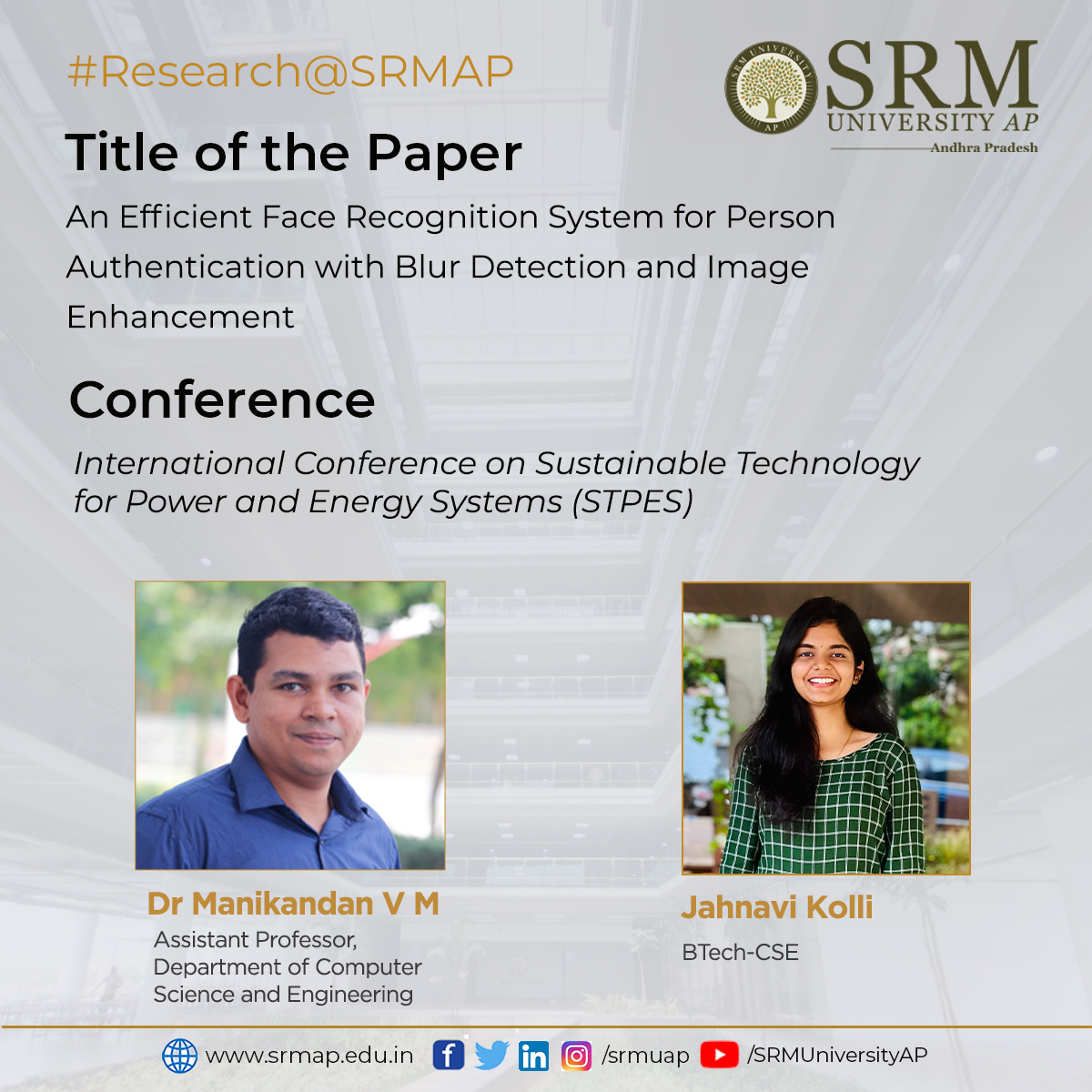 Jahnavi Kolli presented her research paper, An Efficient Face Recognition System for Person Authentication with Blur Detection and Image Enhancement, at the International Conference on Sustainable Technology for Power and Energy Systems (STPES). The conference was organised by NIT Srinagar and IIT Jammu, India, and was held from July 4 to 8, 2022. The research work was monitored by Assistant Professor V M Manikandan and done in collaboration with Professor Yu-Chen Hu, Providence University, Taiwan. The proposed computer face recognition systems can be used to record the attendance of students in class or employees in the office in an easy way. In the future, the researchers plan to improve the face recognition systems, which will perform better when the images are captured using low-resolution cameras or the face regions occluded for some reasons.
Jahnavi Kolli presented her research paper, An Efficient Face Recognition System for Person Authentication with Blur Detection and Image Enhancement, at the International Conference on Sustainable Technology for Power and Energy Systems (STPES). The conference was organised by NIT Srinagar and IIT Jammu, India, and was held from July 4 to 8, 2022. The research work was monitored by Assistant Professor V M Manikandan and done in collaboration with Professor Yu-Chen Hu, Providence University, Taiwan. The proposed computer face recognition systems can be used to record the attendance of students in class or employees in the office in an easy way. In the future, the researchers plan to improve the face recognition systems, which will perform better when the images are captured using low-resolution cameras or the face regions occluded for some reasons.
Explanation of the research
The recent advancements in technology widely help to substitute manpower with machines in a better way. Even though machines are increasingly replacing humans in various ways, there are still a few areas where the use of machines still needs to be explored much more efficiently. Facial recognition systems are one such field. Facial recognition systems are used with various motives, such as identification of suspects in public places, authentication of users on restricted premises, etc. In this work, we propose a facial recognition system to facilitate the authentication of students at the university entrance. The same scheme can also be utilised to authenticate the students before entering examination halls. As the strength of the students at universities increases in a more significant way, it becomes strenuous for the security people to record their attendance manually, which frequently results in erroneous data. This paper proposes a facial recognition system that will help to capture the live videos from an area of interest and identify the faces. Further, a face recognition scheme will detect whether the person is authorised or not. Several facial recognition systems are already available in the literature, and this scheme differs from them in many ways. The proposed method selects the frames with less blur for face detection and further face recognition. A blur detection scheme is used in the proposed system to analyse the amount of blur in the image. To overcome the challenges such as low accuracy during face recognition when the images are taken in low lighting conditions, we use a histogram equalization method to enhance the quality. The experimental study shows that the proposed approach works well in real-time.
- Published in CSE NEWS, Departmental News, News, Research News
Combining intelligent systems for social good
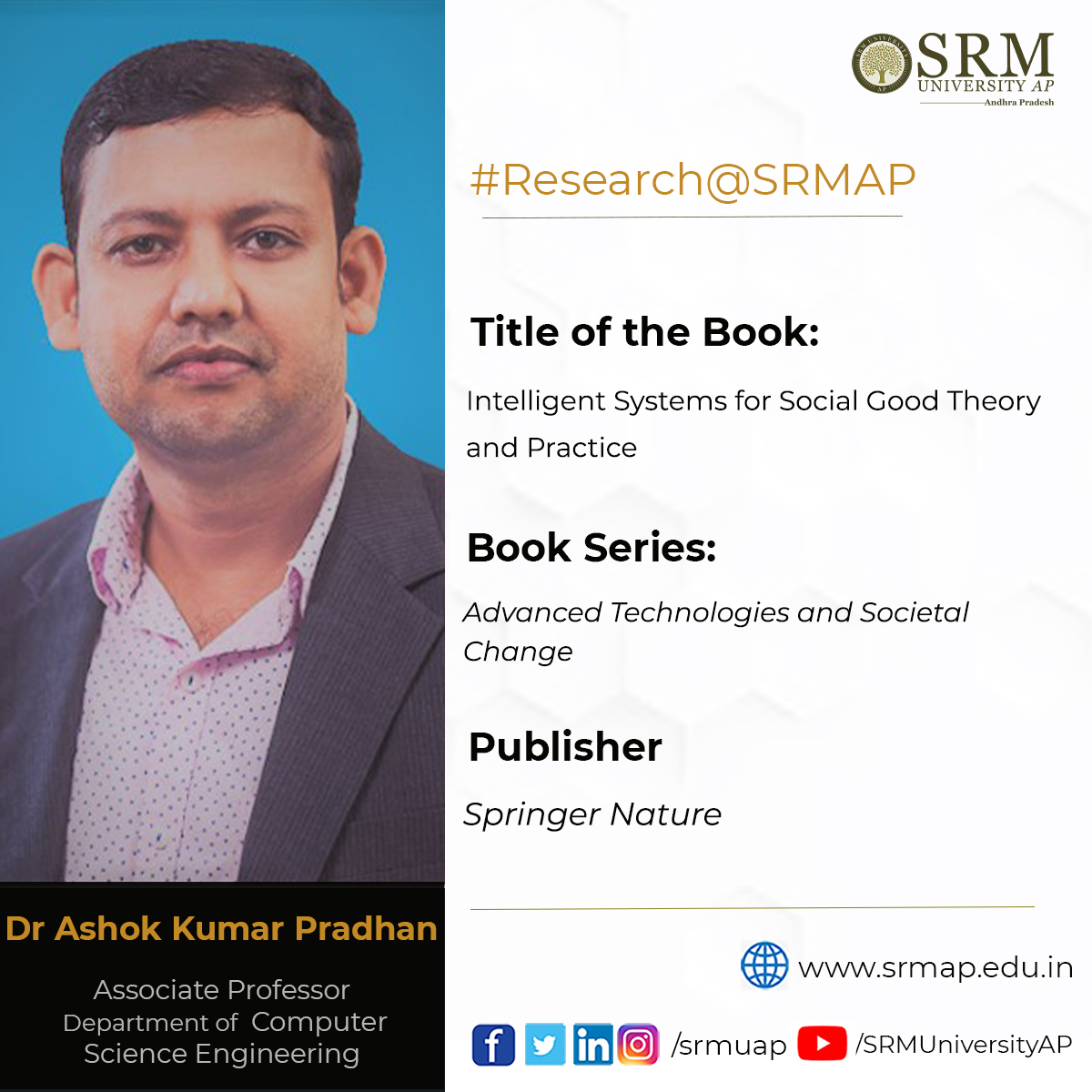 Merging the calibre of two well-fledged technologies will massively impact the momentum of social life. Decoding the possible links between promising technologies would employ solutions to various societal issues. Dr Ashok Kumar Pradhan, Associate Professor of the Department of Computer Science and Engineering, gave life to this thought by publishing a book titled Intelligent Systems for Social Good Theory and Practice. He published this work as an editor in a book series named Advanced Technologies and Social Change by Springer Nature.
Merging the calibre of two well-fledged technologies will massively impact the momentum of social life. Decoding the possible links between promising technologies would employ solutions to various societal issues. Dr Ashok Kumar Pradhan, Associate Professor of the Department of Computer Science and Engineering, gave life to this thought by publishing a book titled Intelligent Systems for Social Good Theory and Practice. He published this work as an editor in a book series named Advanced Technologies and Social Change by Springer Nature.
The book highlights the connection between the two technologies: Artificial intelligence (AI) and the Internet of Things (IoT). It shows the better impact of the relation between these technologies in society, using real-world examples. Each chapter in the book proposes novel solutions to societal problems along with the challenges in the application of AI and IoT to solve them. The adverse attacks on Machine Learning models and how to protect sensitive data over the IoT network are discussed in the book.
The book is significant to Dr Ashok Kumar Pradhan as applying the two technologies mentioned helps resolve various social problems related to healthcare, agriculture, green environment, renewable energies, smart cities, etc.
Shyamapada Mukherjee and Naresh Babu Muppalaneni from NIT Silchar and Sukriti Bhattacharya from Luxembourg Institute of Science and Technology, Belvaux, have worked together with Dr Ashok for this work. The book’s target audience is undergraduate, master’s, and doctoral students from Science and Engineering backgrounds.
- Published in CSE NEWS, Departmental News, News, Research News
Tummala Bhuvitha bags 3 gold in state-level rifle shooting
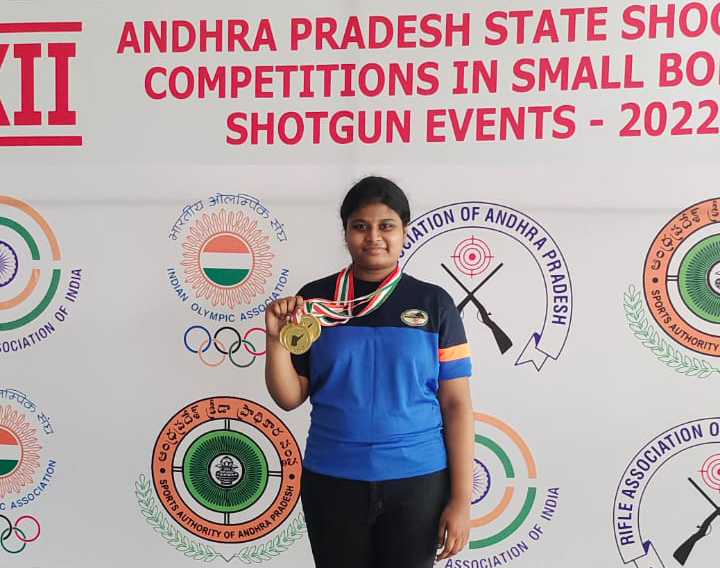
Tummala Bhuvitha, Computer Science Engineering student at SRM University-AP showed exceptional talent in the 22nd state-level rifle shooting competition organised at Hyderabad Central University under the aegis of the National Rifle Association of India. She won the first position and 3 gold medals in the 10m air rifle shooting competitions held in senior, junior and youth categories, respectively.
More than 100 shooters from Andhra Pradesh took part in the competition held from the 4th to 7th of this month. Participating in the competition from SRM AP, Bhuvitha stunned the organisers by winning three gold medals in a row. Bhuvitha had won gold medals twice in the past in state and national level rifle shooting competitions held in different places. According to her father, Bhuvitha learned shooting techniques from Subrahmanyeshwar Rao, the coach at the Indian Academy of Shooting Sports in Vijayawada.
“I grew passionate about rifle shooting because it is an individual sport that requires so much concentration and focus”, says Ms Bhuvitha while sharing the joy of her success. University President Dr P Satyanarayanan, Vice-Chancellor Prof V S Rao and Registrar Dr R Premkumar praised Bhuvitha for winning three gold medals consecutively in state-level competitions.
- Published in CSE NEWS, Departmental News, News, Sports News, student affairs news, Students Achievements
Facial recognition system
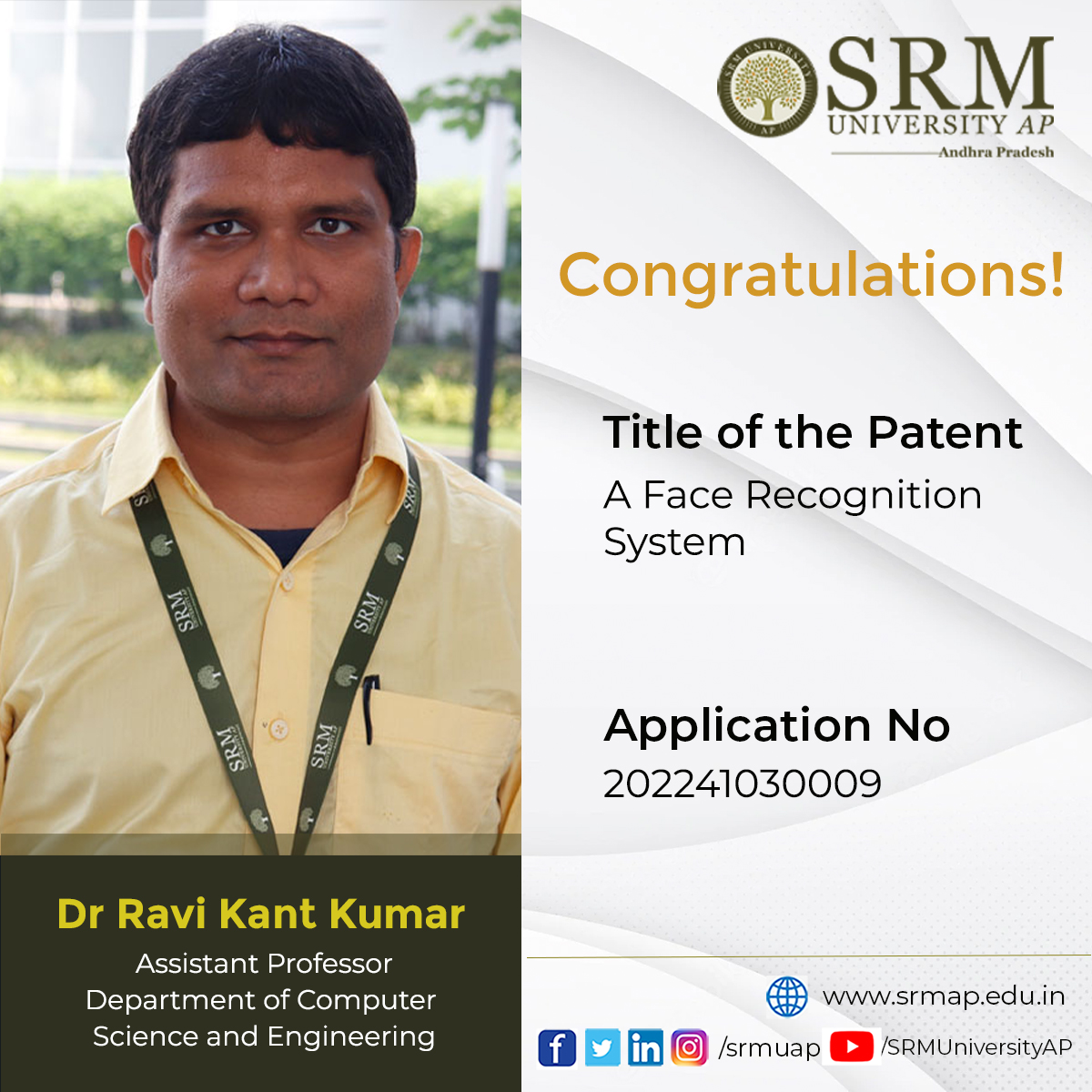 Assistant Professor Dr Ravi Kant Kumar of the Department of Computer Science and Engineering aspires to investigate and design the most effective face recognition system appropriate enough to recognise faces in various unconstraint environments. Recently, his patent application titled A Face Recognition System (Application number: 202241030009) got published. He collaborated with his BTech student Thota Venkata Saai Praneeth, for this project. Facial recognition systems have abundant applications in Face Identification, Automobile Security, Access Control, Immigration, Education, Retail, Healthcare, Image database investigations, Surveillance, and many more.
Assistant Professor Dr Ravi Kant Kumar of the Department of Computer Science and Engineering aspires to investigate and design the most effective face recognition system appropriate enough to recognise faces in various unconstraint environments. Recently, his patent application titled A Face Recognition System (Application number: 202241030009) got published. He collaborated with his BTech student Thota Venkata Saai Praneeth, for this project. Facial recognition systems have abundant applications in Face Identification, Automobile Security, Access Control, Immigration, Education, Retail, Healthcare, Image database investigations, Surveillance, and many more.
Abstract
A facial recognition system is used for matching a human face captured in an image or a video frame with a database of faces. The system generally authenticates users by measuring facial features from the stored images. The present disclosure relates to face recognition systems. The envisaged system comprises a repository comprising a set of facial images of a plurality of subjects, a set of threshold values, and a plurality of rules. The system further comprises an image capturing unit for capturing a plurality of images of a subject’s face. A segmentation unit divides each image into a plurality of frames. The system further comprises a classifier that receives the frames and classifies frames containing faces from frames containing non-faces from the other frames. The facial features of each frame are extracted by an extractor. An analyser receives the extracted facial features and computes eigenvector values of the facial features of the frame. A comparator compares the computed eigenvector values with threshold values using the comparison rules to identify the subject.
Explanation of the research
Conventional facial recognition systems are configured to identify the contours of a person’s image captured by a camera or in real-time and compare it with the stored image to identify the person. However, external factors such as position, light conditions, camera calibration, and unconstraint conditions, among others, affect the identification of the face of the subject. Hence, comparing the faces with the help of the contours is not reliable. The present disclosure envisages a face recognition system. The system comprises a repository, an image capturing unit, a segmentation unit, a classifier, an extractor, an analyser, and a comparator. The repository consists of a set of facial images of a plurality of subjects, wherein the images define the subject’s facial features in different facial poses. Each image is tagged with an identity, a threshold integral value, and threshold eigenvector values corresponding to the facial features. The repository further comprises a first set of deep learning rules for classifying frames of a captured image into frames containing faces and frames containing non-faces, a set of extraction rules for extracting facial features from the frames 20 containing faces, the second set of deep learning rules for extracting eigenvector values of facial features of the frames containing faces. The repository additionally comprises a set of comparison rules for comparing eigenvector values of the captured facial features with the stored threshold eigenvector values to identify a subject’s face in the captured image.
- Published in CSE NEWS, Departmental News, News, Research News
Patient’s E Healthcare Records Management System
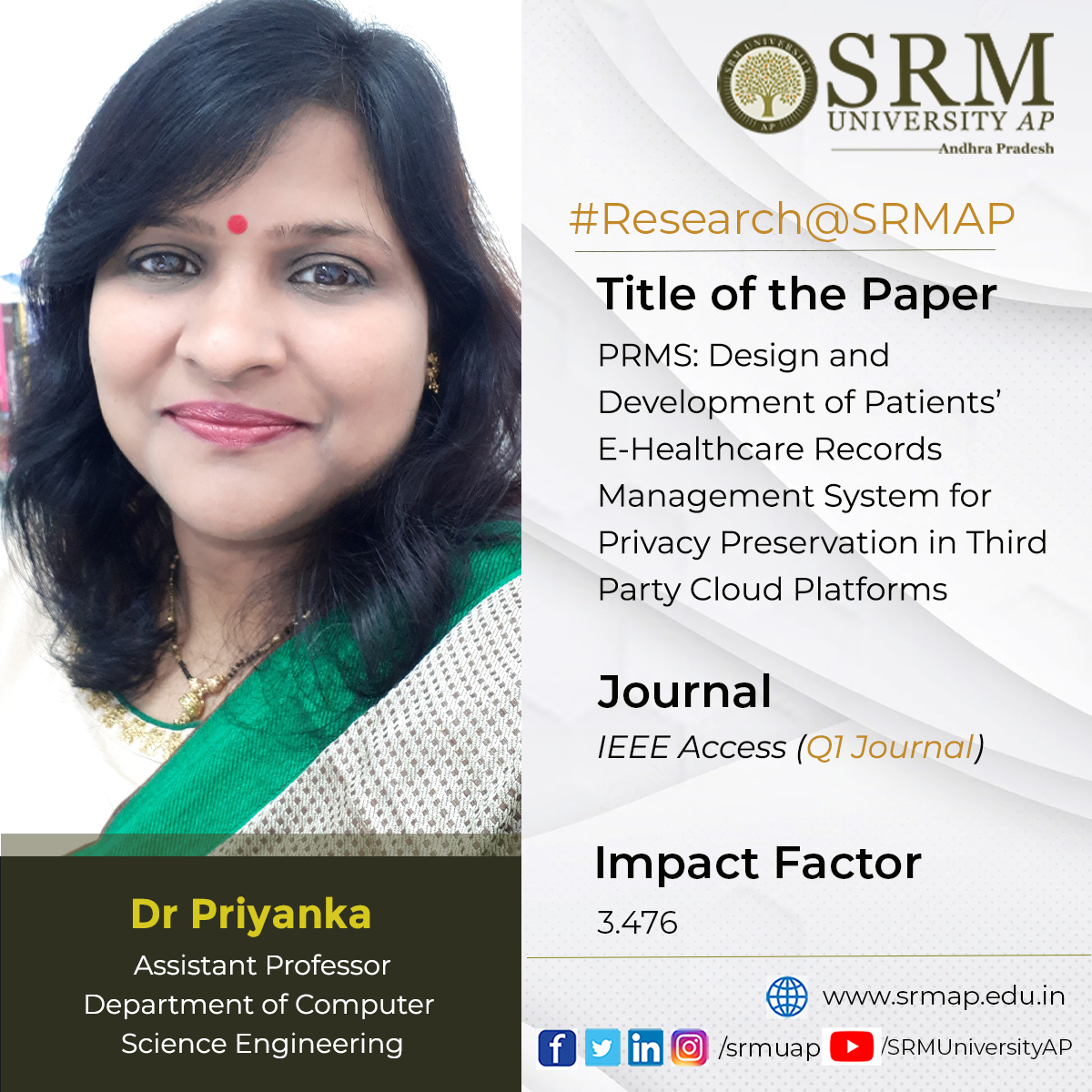 Publishing papers in Q1 journals is a remarkable accomplishment for research enthusiasts. Assistant Professor Dr Priyanka of the Department of Computer Science and Engineering published her latest research paper in the IEEE Access journal. The paper titled PRMS: Design and Development of Patients’ E-Healthcare Records Management System for Privacy Preservation in Third Party Cloud Platforms has an impact factor of 3.476. Kirtirajsinh Zala, Hiren Kumar Thakkar, Rajendrasinh Jadeja, Priyanka Singh, Ketan Kotecha, and Madhu Shukla co-authored the work with Dr Priyanka.
Publishing papers in Q1 journals is a remarkable accomplishment for research enthusiasts. Assistant Professor Dr Priyanka of the Department of Computer Science and Engineering published her latest research paper in the IEEE Access journal. The paper titled PRMS: Design and Development of Patients’ E-Healthcare Records Management System for Privacy Preservation in Third Party Cloud Platforms has an impact factor of 3.476. Kirtirajsinh Zala, Hiren Kumar Thakkar, Rajendrasinh Jadeja, Priyanka Singh, Ketan Kotecha, and Madhu Shukla co-authored the work with Dr Priyanka.
Abstract
In the digital era, personal data storage on public platforms is a significant cause of concern with severe security and privacy ramifications. This is true especially in e-health data management since patients’ health data must be managed following a slew of established standards. The Cloud Service Providers (CSPs) primarily provide computing and storage resources. However, data security in the cloud is still a major concern. To overcome e-healthcare records privacy issues in a third-party cloud, we designed a Patient’s E Healthcare Records Management System (PRMS) that focuses on latency and throughput. Moreover, the proposed PRMS system is compared with Blockchain platforms such as Hyperledger Fabric v0.6 and Etherium 1.5.8 against latency and throughput by adjusting the workload for each platform up to 10,000 transactions per second. The proposed PRMS is compared to the Secure and Robust Healthcare Based Blockchain (SRHB) approach using Yahoo Cloud Serving Benchmark (YCSB) and small bank datasets. The experimental results indicate that deploying PRMS on Amazon Web Services decreases System Execution Time (SET) and the Average Delay (AD) time by 2.4%, 8.33%, and 25.15%, 15.26%, respectively. Deploying PRMS on the Google Cloud Platform decreases System Execution Time (SET) and Average Delay (AD) by 2.27%, 2.4%, and 2.72%, 4.73% AD, respectively.
- Published in CSE NEWS, Departmental News, News, Research News
SRM AP begins the youth empowerment and skill development programme
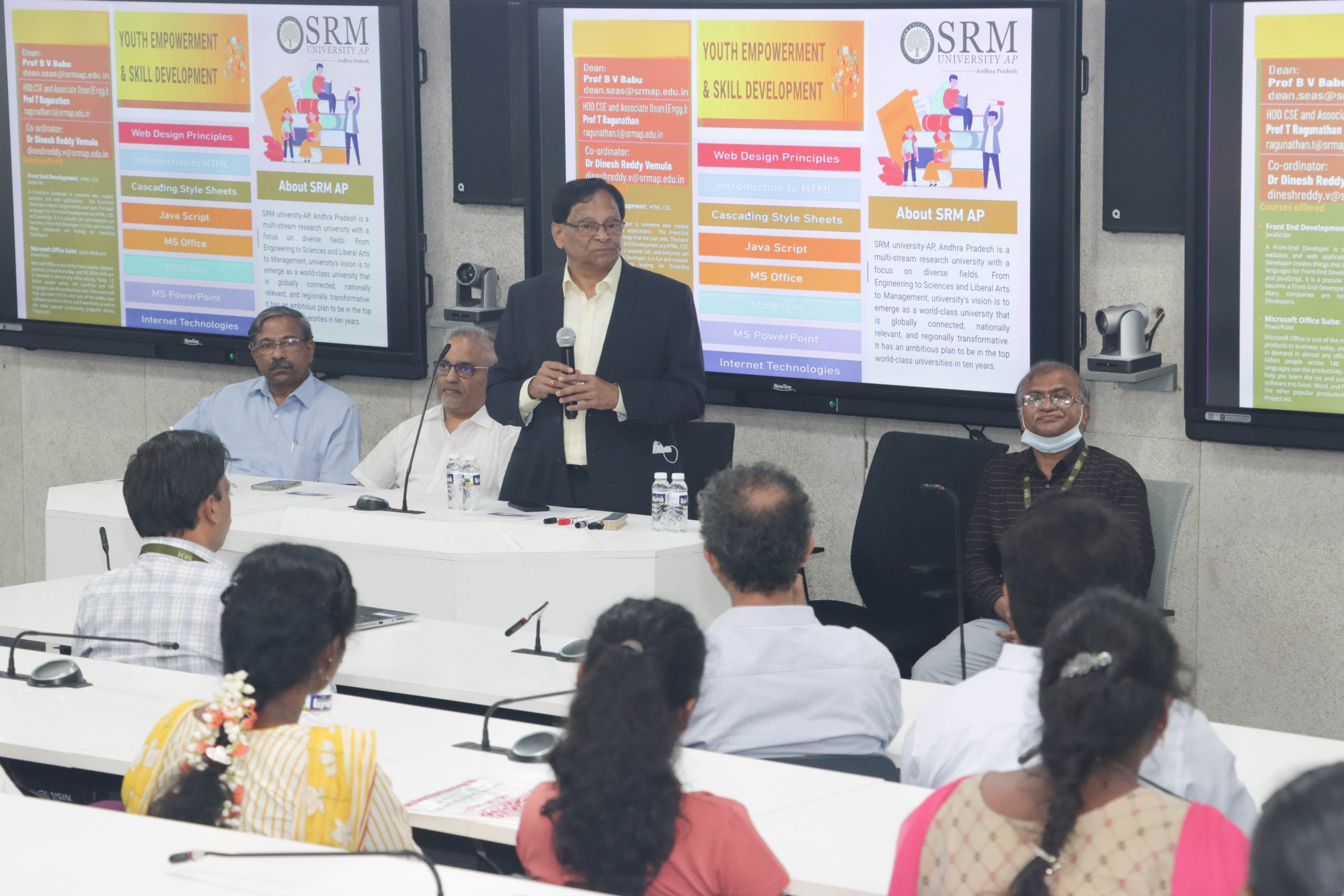
The Department of Computer Science and Engineering at SRM University-AP commenced a one-month-long programme on “Youth Empowerment and Skill Development” with its inaugural ceremony on August 29, 2022. The programme, organised under the ISR activities of the university, is an exclusive initiative for young people living in the vicinal rural communities to enhance and develop their technical and computing skills that will augment their possibilities for a better livelihood.
At the inaugural function, Prof T Ragunathan, Associate Dean- SEAS & the Head of the Department welcomed the gathering. He expressed the university’s objective in conducting the programme and how it would create far-reaching implications in the personal and professional development of the rural youth. Honourable Vice-Chancellor Prof VS Rao delivered the inaugural address and appreciated such dedicated and active initiatives aiming at the holistic welfare of society. “Equitable development of the society should be the vision of the modern education, enabling the young generation of this country to grow into the greatest wealth of our nation”, he remarked.
Prof BV Babu, Dean-SEAS presided over and emphasised the necessity of facilitating and preparing the youth to face the challenges of a technology-driven world. Digital literacy and computer awareness have become the inevitability of present times, causing a marked shift in the operations of the secondary and tertiary sectors. Registrar Dr R Premkumar also addressed the gathering. An empowered youth with digital and computer expertise will keep the country’s future safe in their hands. The Programme coordinator Dr V Dinesh Reddy, Assistant Professor- Department of Computer Science and Engineering proposed the vote of thanks.
The programme received an overwhelming response from around fifteen neighbouring villages. As part of the workshop, courses will be offered on web designing and internet technologies such as Front-End Development and Microsoft Office Suite.. Students will be introduced to basic web designing principles, MS office, Javascript, HTML, etc. Classes will be held from August 29, 2022, to September 28, 2022, from 5.30 pm to 7.00 pm at the university premises.
- Published in CSE NEWS, Departmental News, News

